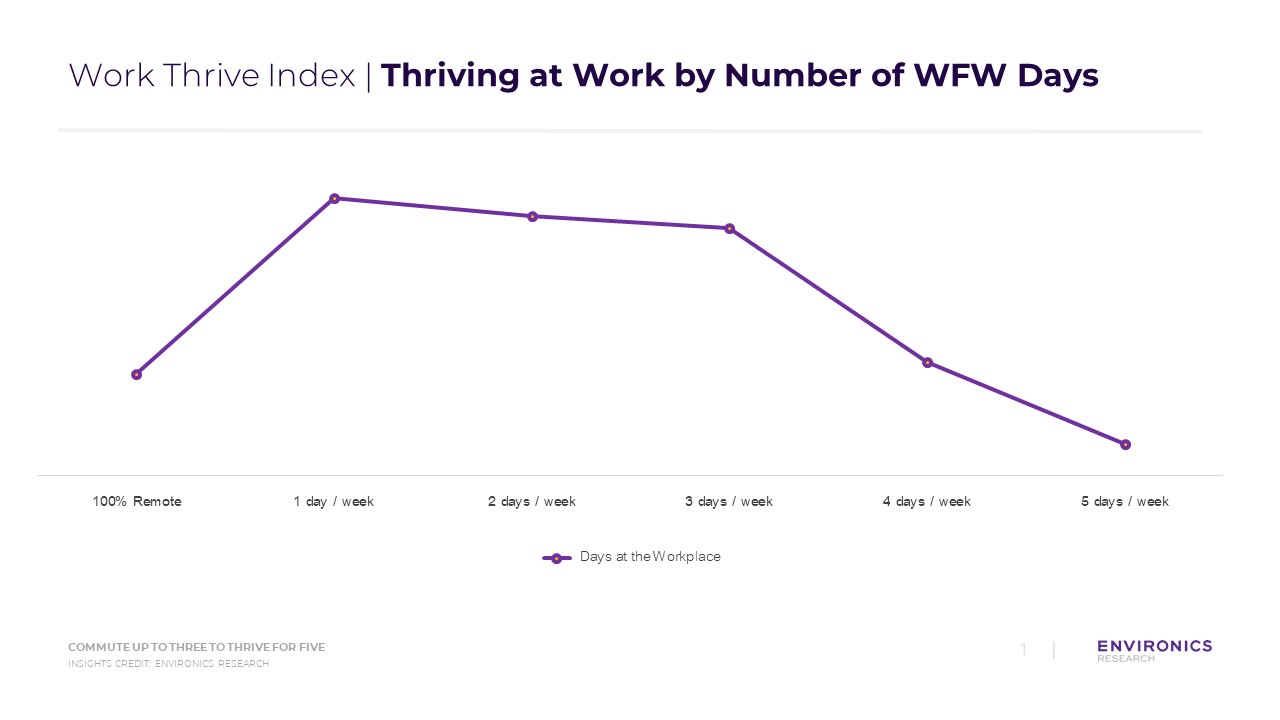Commute Up to Three to Thrive For Five
Workplace thriving is highest among employees who can work remotely two or more days per week.
ARTICLE BY DAVID JAMIESON
As the COVID-19 pandemic subsided, many organizations hoped their employees who had worked from home during the crisis would return to the office – at least part of the time. For some employers, hoping turned into coaxing, then pressuring, and ultimately insisting. Many leaders agreed that they wanted to stop seeing their expensive offices sit empty, and start seeing a return to in-person, high-productivity, high-collaboration workplaces.
The “new normal” has varied widely across different organizations. Some employers have brought everyone back full time, some have set almost no requirements regarding in-person workdays, and many have landed in the middle. Meanwhile, some employees have voted with their feet, moving to organizations whose policies suit them.
But is there an ideal approach? How many days in the office support that elusive balance: productivity and satisfaction at work and enough work-from-home time to give the week a pleasing, livable rhythm (time for errands, a break from commuting, a workout or two)?
Environics conducted some research to seek the answer.
The foundational survey for our corporate culture practice was conducted in the spring of 2023, when companies were struggling to determine how much at-work time their organizations needed, how much employees would accept, and how to draw people back. Our sample included Canadian workers (both full-time and part-time, as well as some unemployed but looking); we recontacted people who had participated in our general 2022 and 2023 Social Values surveys. The new workplace survey measured several organizational values and experiences. It also explored two additional questions: how much time respondents were working at work (and at home) and how much they felt they were thriving in their jobs.
It’s important to note that our sample includes workers from all kinds of roles and sectors, meeting all kinds of requirements and demands. Our conclusions about the optimum number of days of “work from work” (WFW) versus “work from home” (WFH) might differ if we were able to analyze by sector, job or other dimensions – but our sample of 1,264 can only permit limited analysis of sub-groups.
Looking at the entire sample, however, we set out to answer the high-level question, “How much on-site work is needed to optimize a workforce’s engagement and satisfaction?” We plotted Canadian full-time employees’ self-reported levels of thriving at work against the number of days per week they worked at an office or other site outside their homes. The idea was to see whether positive engagement and satisfaction peaked at a particular number of WFW days.
To measure flourishing at work, we used our new Work Thrive Index, a high-reliability, summed index of four separate but equally weighted measures: work satisfaction, willingness to recommend one’s place of employment to others (net promoter score), a sense of connection to one’s job and co-workers, and finally, the emotional quality—positive, neutral or negative—of how, upon reflection, their work has been making them feel lately. This last question is based on a classic projective technique called the “Treemen”, a qualitative assessment we were able to implement at scale in partnership with our research partner Nexxt Intelligence, using their AI-enhanced survey platform (“inca”). Here is what inca’s Treeman looks like (our respondents were asked to pick the one figure that best describes how they have been feeling lately at work):


As this chart shows, totally remote workers (with zero WFW days, on the left) express a moderate degree of thriving. That’s not too surprising. People who work only from home have likely self-selected to a large degree, either choosing or remaining in jobs that enable WFH most of the time. It makes sense that they’d be fairly happy with the arrangement. On the downside, those whose work is mainly virtual do miss out on at-work experiences not easily replicated on zoom calls. Even if they’ve chosen to opt out, the lack of in-person engagement might be having a negative effect on them. For most people, it is a mix of solitary and social achievements at work that is most rewarding; fully remote workers miss one side of that balance.
We were more surprised, however, at the large dip in reported thriving among those who have five at-work days per week. A few different explanations are possible. Perhaps jobs that require full attendance (e.g., very active service jobs) by nature provide fewer opportunities to thrive. Or it may be that these low levels of thriving reflect some resentment among people constrained to WFW full-time while many of their peers are able to work more flexibly in hybrid arrangements, if they choose to.
Whatever the patterns at the extreme ends of the spectrum, thriving is clearly highest in the middle, where people report working from home between one and three days per week. This finding does seem to support the idea that people benefit from having some control of where they spend the work week.
Perhaps even a single day working from home gives people what they’ve been saying they need for quite some time: the right mix of quiet, concentrated time and active, collaborative time to work – plus a little room to handle personal obligations during the week, keeping their lives sane and in balance.
While the Goldilocks number seems to be somewhere within the range of one to three days at work, further analysis of our data leads us to a more precise answer for the optimum WFW days per week for most employers and employees. In a post next week, I’ll reveal that answer and the reasons for it.
Find out how our team can help your organization
Related insights



Toronto
366 Adelaide Street West
Suite 101, Toronto, ON
Canada M5V 1R9
416 920 9010
Ottawa
135 Laurier Ave W.
Ottawa, ON
Canada K1P 5J2
613 230 5089
Calgary
421 7th Ave SW
Suite 3000, Calgary, AB
Canada T2P 4K9
403 613 5735
